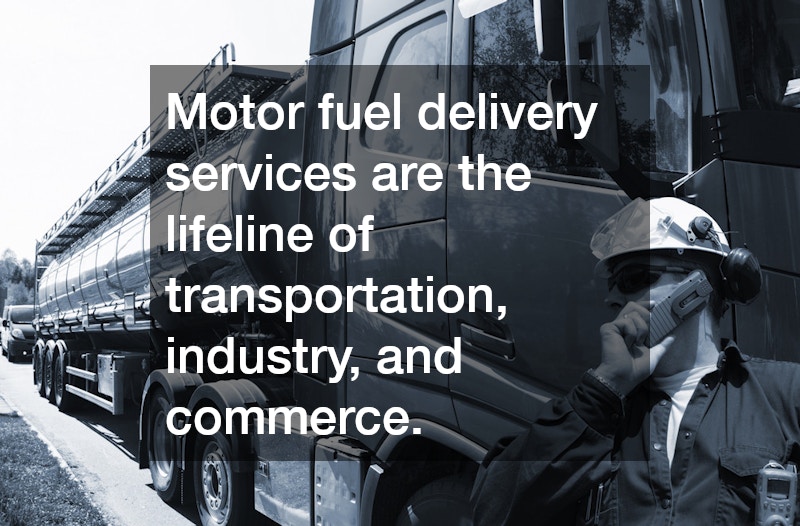Motor fuel delivery services are the lifeline of transportation, industry, and commerce. From fueling gas stations to supplying construction sites and fleet operators, these services ensure that energy is always available where it’s needed most. Yet, despite their critical importance, few people understand just how intricate and advanced the world of motor fuel delivery really is. Beyond simply moving gasoline or diesel from one point to another, the industry depends on complex logistics networks, cutting-edge technology, and strict regulatory compliance to keep economies moving efficiently and safely.
How Do Motor Fuel Delivery Services Operate?
Supply Chain and Logistics
At the heart of every fuel delivery operation lies a finely tuned supply chain. Fuel begins its journey at refineries, where it’s processed from crude oil.
It’s then transported to bulk storage terminals before being distributed to end users such as gas stations, fleet yards, or even individual consumers through mobile delivery. Coordinating this process requires careful planning and precision. Delivery routes, timing, and storage capacity must all align to ensure timely and cost-efficient operations. Even a small disruption—like a refinery outage or transportation delay—can have ripple effects throughout the supply chain.
Technology in Fuel Delivery
Modern technology has transformed fuel delivery into a data-driven operation. GPS tracking, route optimization software, and automated dispatch systems allow companies to monitor their fleets in real time. Many fuel delivery trucks are now equipped with Internet of Things (IoT) sensors that measure temperature, pressure, and volume to prevent spillage or contamination. Some companies also use digital ordering platforms and apps, allowing customers to schedule and monitor deliveries instantly. These innovations not only improve efficiency but also enhance transparency and customer satisfaction.
Safety Regulations and Compliance
Fuel delivery involves the handling of flammable and potentially hazardous materials, making safety regulations paramount. Drivers and operators must comply with Department of Transportation (DOT) standards and hazardous material (HAZMAT) training requirements. Tankers are regularly inspected to meet federal and local safety guidelines, and drivers must follow strict protocols during loading and unloading. Compliance isn’t just about avoiding fines—it’s about preventing accidents, protecting communities, and maintaining public trust.
Environmental Impact and Regulations
As environmental awareness grows, fuel delivery companies are under increasing pressure to operate sustainably. Regulations such as the Environmental Protection Agency’s (EPA) standards require fuel carriers to minimize emissions and prevent leaks. Many companies are investing in cleaner technologies—such as low-emission delivery vehicles and vapor recovery systems—to reduce their carbon footprint. Some are even transitioning to delivering alternative fuels like biodiesel or renewable diesel, helping industries meet sustainability goals without compromising reliability.
Role of Transportation Vehicles
Fuel delivery trucks are not your average vehicles. They’re engineered with multiple compartments, advanced pumping systems, and built-in safety mechanisms to prevent overfilling or contamination. These tankers must balance heavy loads across long distances while maintaining stability and safety. Additionally, specialized vehicles are often used for delivering different fuel types—ranging from diesel and gasoline to aviation fuel—each requiring its own set of handling standards.
What Are the Benefits of Using Motor Fuel Delivery Services?
Convenience for Businesses and Individuals
Fuel delivery services eliminate the need to travel to a gas station or coordinate bulk pickups. Businesses can schedule on-site refueling, ensuring their vehicles and machinery are always ready to operate. Homeowners who rely on fuel for heating or backup generators can also enjoy doorstep delivery, making energy access easier than ever.
Cost-Effectiveness
Outsourcing fuel delivery can lead to significant savings. Companies avoid the overhead costs of maintaining their own storage tanks and transportation fleets. Additionally, bulk purchasing and optimized delivery routes help lower per-gallon costs, which is especially beneficial for commercial clients with high fuel demands.
Improved Time Management
Time is money, especially in industries that rely heavily on vehicles and equipment. Scheduled fuel deliveries ensure that operations run smoothly without interruptions caused by refueling downtime. This level of predictability allows businesses to focus on productivity rather than logistics.
Enhanced Safety Measures
Professional fuel delivery companies adhere to strict safety standards that far exceed those of typical self-service fueling. Their personnel are trained to handle emergencies, use specialized equipment, and manage environmental risks effectively. This minimizes liability for businesses and ensures that refueling is done safely every time.
Access to Remote Locations
In many rural or remote areas, access to fuel can be a challenge. Motor fuel delivery services bridge that gap, providing reliable fuel access to farms, construction sites, mining operations, and other hard-to-reach places. This accessibility is vital for keeping essential industries and communities running smoothly.
Challenges Faced by Motor Fuel Delivery Services
Fluctuating Fuel Prices
Volatile global oil prices directly affect delivery costs. Companies must constantly adjust pricing strategies to balance profitability with customer satisfaction.
Infrastructure Limitations
Aging infrastructure—such as deteriorating roads or limited storage facilities—can disrupt delivery schedules and reduce efficiency.
Regulatory Changes
Constantly evolving safety and environmental regulations require companies to adapt quickly, often involving significant financial investment in compliance and training.
Competition in the Industry
The fuel delivery market is highly competitive, with companies striving to offer faster, safer, and more sustainable services. This competition drives innovation but also increases pressure to reduce costs.
Demand Forecasting
Predicting fuel demand can be complex, influenced by factors such as weather, economic shifts, and seasonal trends. Inaccurate forecasts can lead to shortages or overstocking, both of which affect profitability.
A motor fuel delivery service is far more intricate than it may appear. They operate at the intersection of logistics, technology, and safety—ensuring that businesses, industries, and individuals always have access to the fuel that powers daily life. Despite challenges like fluctuating prices and evolving regulations, the industry continues to innovate and adapt. Understanding these behind-the-scenes efforts reveals just how vital motor fuel delivery services are to the smooth operation of modern society.

